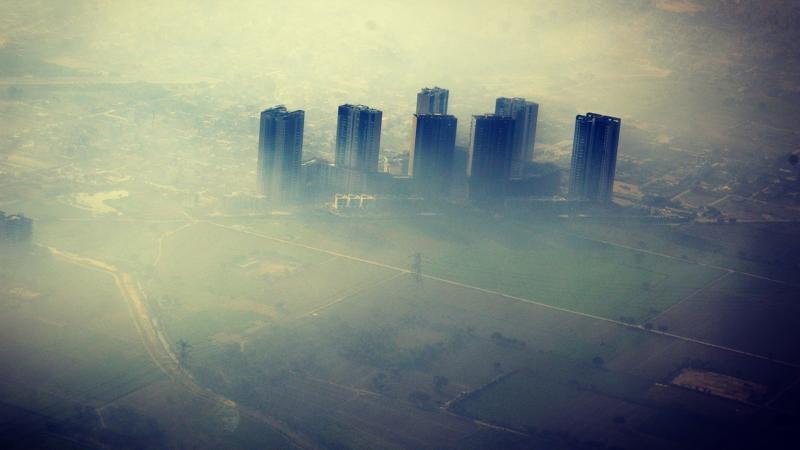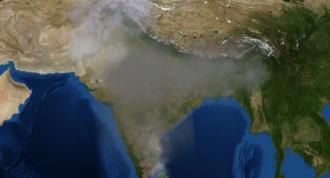
Researchers study emissions and their sources in 20 Indian cities
India is battling severe air pollution and here are some grim and dismal statistics to back it up. Delhi, the capital city, is one of the most polluted cities in the world, and in November 2018, the Air Quality Index (AQI), a metric to measure how polluted the air is, skyrocketed to 1000 in many areas of the city. These levels were at least thrice the deemed hazardous levels of 300. Air pollution has been linked to a host of issues, ranging from poor crop yield to innumerable health issues such as lung cancer, diabetes, cardiovascular diseases, asthma, bronchitis, dementia, and low birth weight, among others.
While this might seem a problem localized to Delhi, the rest of India doesn’t fare well either. Fourteen of the top fifteen polluted cities in the world are in India. So far, the primary focus of studies on air pollution in the country has been on Delhi, and to a lesser extent, on Mumbai and Kolkata. In fact, it is estimated that close to 99.5% of the 640 districts in India exceed the World Health Organization 2016 guidelines for particulate matter emissions of 10 μg/m. Now, a recent study has investigated the emission levels of multiple pollutants in twenty Indian cities, other than Delhi.
The study, undertaken by researchers from the Desert Research Institute, USA and Urban Emissions—a repository of research, information and analysis about of air pollution, has explored the ambient air quality of these cities and built a high-resolution 'emissions inventory' of multiple pollutants. An emissions inventory accounts the pollutants discharged into the atmosphere from all sources in a specified period in an airshed—an area within which the air is channelled. The findings of the study were published in the journal Urban Climate.
"Pollution knows no boundaries, goes a saying, implying that we cannot model it confined to an administrative boundary of a city or a district", says Dr Sarath Guttikunda, the lead author of the study. Since there is no standard measure for what an airshed is, scientists randomly draw a box around the central urban agglomeration and extend to include as many influential air pollution sources as possible. "For example, if there is a power plant 20 km away from the city, or clusters of brick kilns or rock quarries, then the airshed includes that," he explains.
The researchers chose 20 Indian cities, from 13 states, including Bengaluru and Chennai—two megacities with a population of over 10 million. The others include Chandigarh, Kanpur, Patna, Pune, Agra, Amritsar, Bhopal, Bhubaneswar, Coimbatore, Dehradun, Indore, Jaipur, Kochi, Ludhiana, Nagpur, Patna, Raipur, Ranchi and Varanasi. In all, these cities have 90 million inhabitants and cover an airshed of 44,000 sq. km.
The researchers collected four categories of data to build the emissions inventory. The first category involved data gathered from various ministries, professional organisations and policymakers. The second category consisted of dynamic data like vehicular speed maps for weekdays and weekends, power consumption and demand data, satellite feeds of open fires, dust events and weather forecasting models. In the third category, monitoring data from the websites of the Central Pollution Control Board and other organisations were considered. The fourth set of data came from Google, where it mapped commercial establishments like cafes, cinema theatres, hotels, hospitals and malls. Using this data, the researchers built the emissions inventory of various pollutants at a spatial resolution of 1 km x 1 km.
Alarming levels of pollution
The researchers found that vehicle exhaust, suspended dust, construction activities, industrial exhaust, domestic cooking and heating are the primary sources of emissions in all cities. In tier-2 cities like Amritsar, Bhopal, Chandigarh, Coimbatore, Kanpur, Ludhiana, and Pune, small and medium-scale industries were found to be significant sources of emissions. They estimated the levels of hazardous pollutants like volatile compounds, black and organic carbon, sulphur dioxide, nitrogen oxides, carbon monoxide and dioxide and particulate matter.

Estimated annual emissions totals for the 20 Indian cities in 2015 [Data source]
Key: CO2 - Carbon dioxide, SO2 - Sulphur dioxide, NMVOC - Non-methane volatile organic compounds, CO - Carbon monoxide, NOx - Nitrogen oxides, OC - Organic Carbon, BC - Black Carbon, PM10 - Particulate Matter 10, PM2.5 Particulate Matter 2.5
The findings show that all of the twenty cities exceed the annual PM10 standard of 60 μg/m3, mostly emitted from the combustion of coal, fossil fuels, biomass, cow dung, and waste as well as dust. Densely populated cities like Chennai, Bengaluru and Pune recorded the highest levels of sulphur dioxide from vehicular and diesel generator emissions. On the other hand, nine cities, including Bengaluru and Chennai, exceeded the annual emission standards for nitrogen dioxide.
The study further focussed on particulate matter emissions, which are small suspended particles of solid or liquid in the air. Owing to their tiny size, often in the scales of millimetres, these particles lodge in the respiratory tract and pose respiratory problems. The researchers used a computer model called the Comprehensive Air Quality Model with Extensions (CAMx) to estimate the concentration of particulate matter (PM10 and PM2.5) in each of the twenty cities. The researchers then compared their estimations with those measured in monitoring stations.
Except for the cities of Bengaluru and Coimbatore, all others exceed the national annual standard of 40 μg/m for PM2.5. Besides, there were significant variations in the concentration values of particulate matter during 24 hours. During winter, the values peaked as compared to that during summer and monsoon. This difference is more in the case of cities lying in the Indo-Gangetic plain than in the cities in South India because the cities are densely populated. There was a 50-100% increase in the ambient PM2.5 levels between 1998 and 2016.

Contributions of different sources to PM2.5 emissions in 2015 [Data Source]
Key: A - domestic cooking, heating and lighting; B - transport including road, rail, shipping, and aviation; C - dust including on-road resuspension and construction; D - brick kilns; E - all industries excluding brick kilns and including thermal power plants; F - open waste burning; G - diesel generator sets; H - natural source for coastal cities; Outside - contribution of regional sources
The study also considered PM2.5 contributions due to activities and emission sources outside urban areas. In cities like Amritsar, Chandigarh and Ludhiana, power plants in the neighbourhood, seasonal dust storms from Rajasthan and stubble burning contributed to about 50-52% of particulate matter. Most cities that had an outside contribution of 30-40% were tier-2 cities, found the study. The researchers also calculated the possible emissions by 2030 if the rate of emissions continued to be as is today, the results of which are available here.
Addressing the pollution crisis
The study also suggests a few actionable steps that could be taken to curtail emissions levels by 2030. A vital step is to push for public transport to reduce the number of passenger vehicles and their emissions. The researchers recommend a sustainable transport policy that includes walking and cycling infrastructure to reduce not only emissions but also on-road dust.
Today, in most cities, waste is burnt in the open without a waste management strategy, contributing significantly to air pollution. The researchers urge municipalities to reduce waste generation, collect waste efficiently and manage it. Besides, upgrading existing chimney-based brick kilns and enforcing stricter emission standards for coal-fueled power plants can help, they say.
The study also pushes for regional air quality management strategy, like the National Clean Air Programme (NCAP) spanning multiple states, districts, and stakeholders to reduce the load of pollution. In this light, the findings of the study—a first-time effort to build an emissions inventory—can help understand the levels and sources of different pollutants. Adding more continuous monitoring stations is an urgent need to fill in the information vacuum, say the authors.
How far can these alarming numbers help act against pollution? “Simply publishing these numbers will not reduce pollution. But, in the absence of any other concrete information, results from this study can support policymakers establish baselines and plot a roadmap to improve air quality in the long run,” concludes Dr Sarath Guttikunda.






